The scene, masterfully rendered in oil on solid wood panel (possibly walnut or chestnut), displays a highly theatrical and balanced composition, arranged in a pyramidal structure. The enthroned Virgin Mary lovingly holds the Christ Child, who gazes tenderly at the elderly king kneeling at His feet. Mary also looks at him with affection and a warm smile, creating an intense emotional connection that becomes the spiritual core of the composition. The devout expression of the kneeling king, who has laid his crown on the ground in humility, completes this emotional triangle with restrained reverence.
The other two Magi appear diagonally: one, elderly, leans forward in a respectful gesture, while the youngest, Black and dressed in sumptuous green and gold, holds a vessel of myrrh with a serene expression of admiration. Saint Joseph, calm and contemplative, stands in the background, flanked by two angels who gently frame the Holy Family, establishing symmetrical balance.
The architectural background is elaborate and symbolic. Classical ruins in ochre and bluish tones evoke the decay of the ancient world before the spiritual rebirth. Behind, a procession of figures and soldiers merges into a receding landscape, illuminated by a radiant star guiding the way to Bethlehem. The soft, atmospheric light bathes the scene with a Mannerist chiaroscuro that enhances the theatricality, intensifying the drapery folds and contrasts between architecture and sky.
The chromatic richness is remarkable: vivid reds, deep greens, luminous golds, and touches of cobalt blue are harmoniously and hierarchically distributed, reserving warm tones for the main figures. The slightly elongated anatomies are typical of Mannerism, with soft modeling that avoids excessive drama in favor of contained spirituality. The expressions are far from static: they convey emotion, affection, humility, devotion, and peace.
Traditionally attributed to Federico Zuccaro, as indicated by a metal plaque on the frame and a handwritten note on the back, the painting is more accurately identified as the work of a close follower. Stylistic analysis shows clear influences of Taddeo Zuccaro and the Roman Mannerism of the late Cinquecento.
Federico Zuccaro (ca. 1540–1609) was one of the most influential figures of late Italian Mannerism, along with his elder brother, Taddeo Zuccaro. Both developed a style characterized by elegance, controlled theatricality, and refined forms. Though Taddeo died young, his legacy continued through Federico, who elevated the Mannerist language into a mature expression, rich in symbolism and technical mastery. Federico worked for major patrons and Popes in Rome, Florence, and Madrid, and was knighted by Philip II. He also founded and served as the first director of the Accademia di San Luca in Rome, promoting humanist artistic education.
This painting belongs to the late Mannerist tradition cultivated by Federico’s followers and disciples, especially in regions like Umbria and Lazio, where his influence was particularly deep between the late 16th and early 17th centuries. These followers preserved the use of pyramidal compositions, elongated figures, and iconography focused on spiritual exaltation through gesture and color.
This type of religious painting, like the Adoration of the Magi depicted here, was especially favored by Zuccaro's circle, as it allowed for not only biblical narrative but also a display of varied garments, expressions, and architectural backdrops. His followers frequently used idealized classical ruins —as in this work— to symbolize the end of the pagan world and the advent of the Christian era, a message aligned with Counter-Reformation thought.
The smiling Christ Child and Virgin, the emotional interaction with the Magi, and the scenic arrangement reflect the didactic and devotional spirit of Italian painting at the end of the Cinquecento. While direct authorship by Federico is not confirmed, the style, technique, and narrative sensitivity of this piece reveal a deep understanding of his models and ideals. The artist who painted this panel clearly mastered his teacher’s principles: compositional balance, expressive intensity without stridency, and solemn chromaticism intended to move the viewer and elevate the spirit.
Ultimately, this painting is a vivid testimony to Zuccaro’s legacy in the decades after his death. It reflects how his visual language continued to inspire and be reinterpreted by artists who, while not achieving his fame, shared his aesthetic sensitivity and spiritual purpose. It is a faithful fragment of central Italian religious painting during the transition to the early Baroque, when Mannerism still flourished as a vehicle for faith and beauty.
The painting is in excellent condition. The paint layer is intact, with stable superficial craquelure consistent with its age. No overpainting or recent additions are visible. The reverse bears notable features: a black ink inscription indicating a sale price of 3000 reales, a high sum for the period, and remnants of a red wax seal with a noble coat of arms, suggesting aristocratic provenance.
The historicist frame is also of great interest, probably made between 1880 and 1920, with water-gilded molding and an arched upper section, elegantly harmonizing with the work. It includes an old plaque inscribed “Fco Zuccaro”.
Its intimate and deeply devotional character makes it ideal for private chapels, domestic altars, or collections of Mannerist sacred art.
An exceptional work combining history, emotion, technique, and beauty.
Dimensions: 54.5 × 39.5 cm (21.46 × 15.55 in). Without frame: 46 × 31.5 cm (18.11 × 12.4 in).
We are professional antique dealers. To see more photos of this item, please click on this link:
https://www.antiguedades.es/en/antique-painting/5311-old-oil-on-panel-adoration-follower-of-zuccaro-italian-school-circa-1600.html




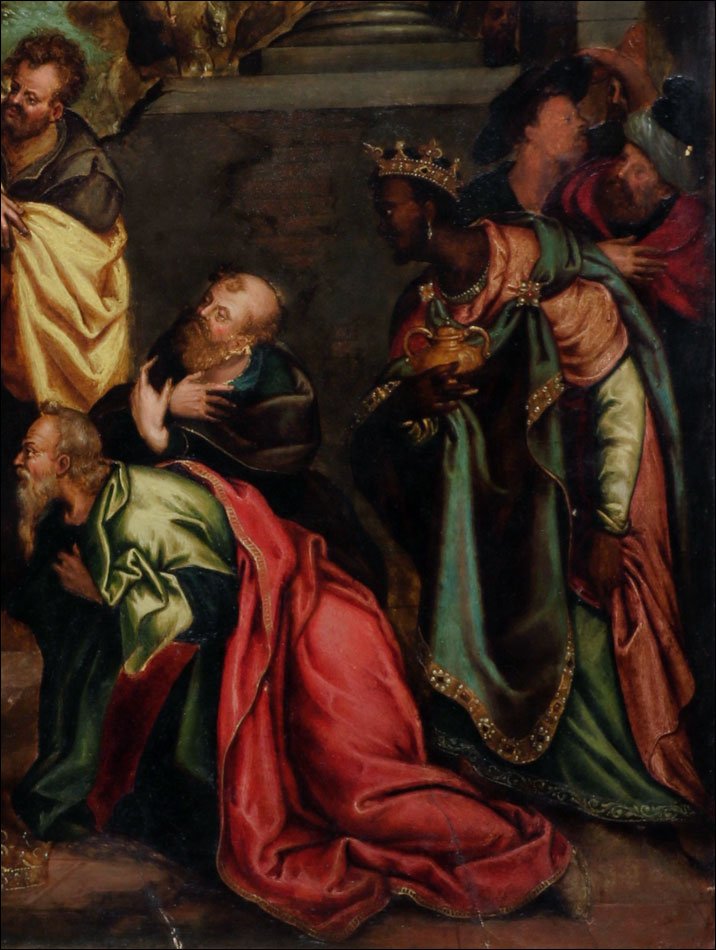

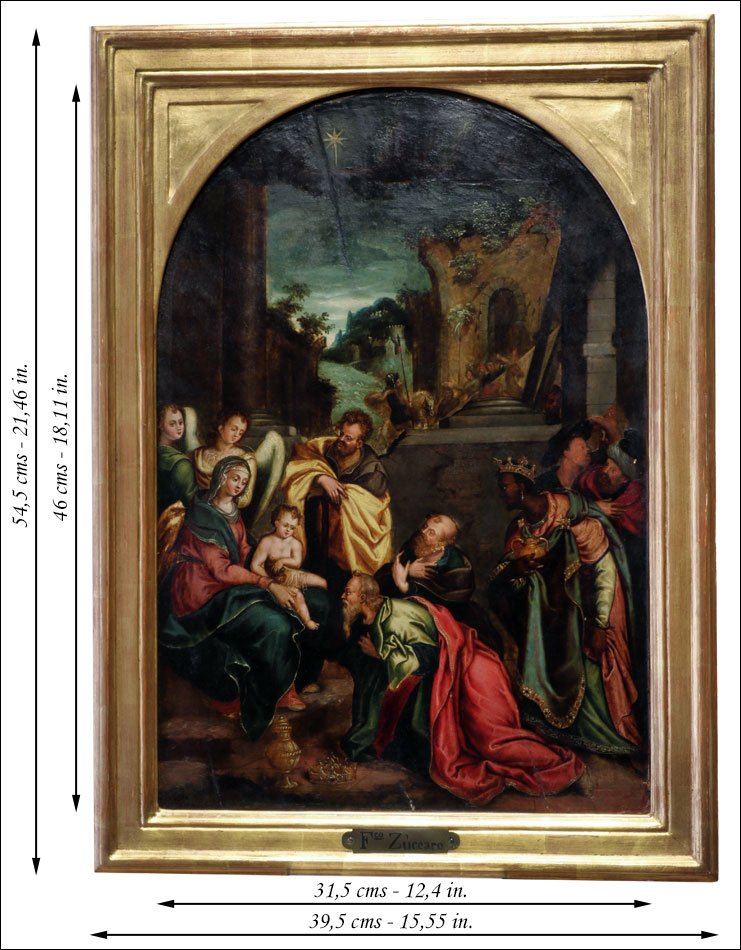

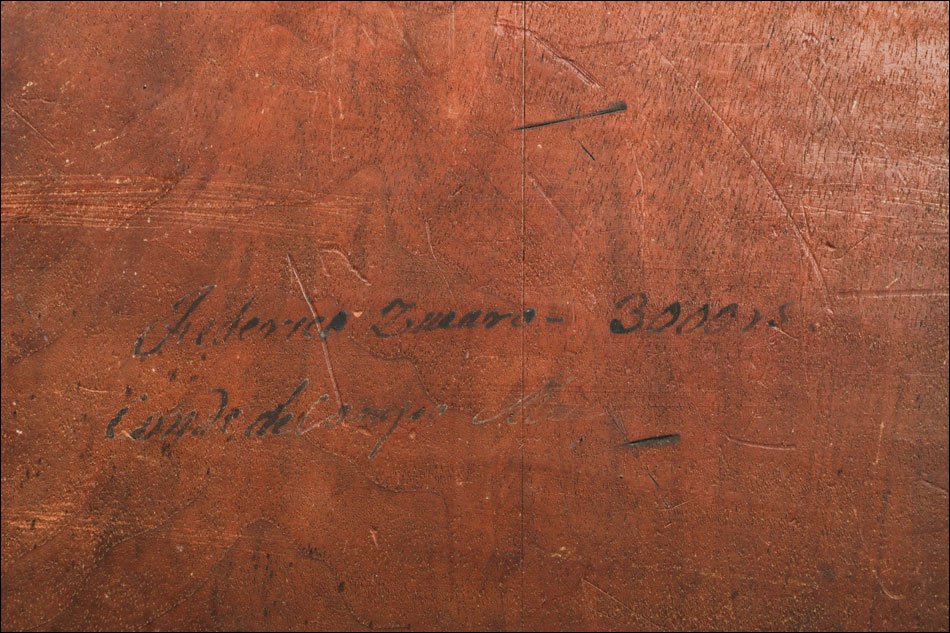

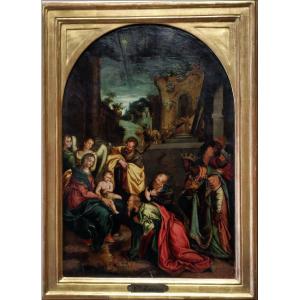









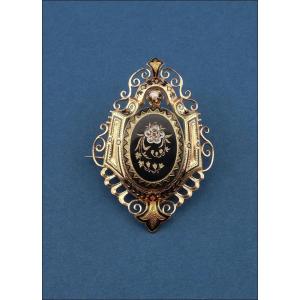





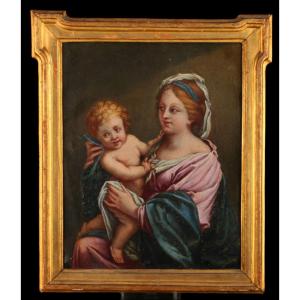









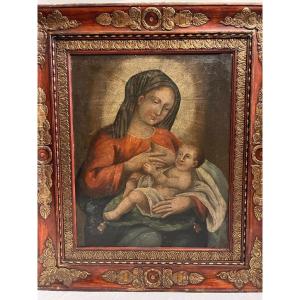





 Le Magazine de PROANTIC
Le Magazine de PROANTIC TRÉSORS Magazine
TRÉSORS Magazine Rivista Artiquariato
Rivista Artiquariato